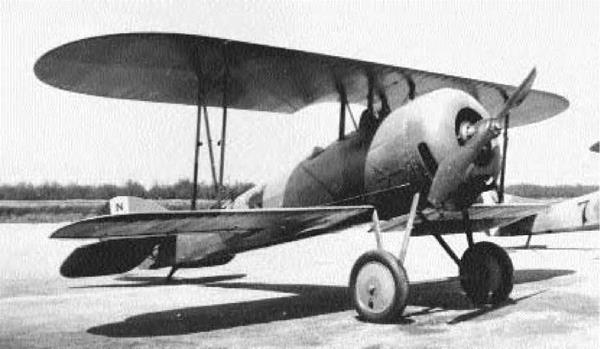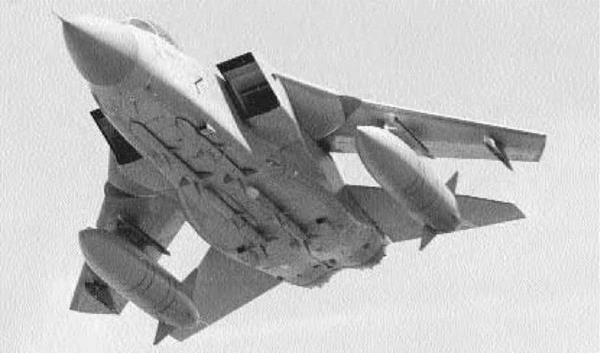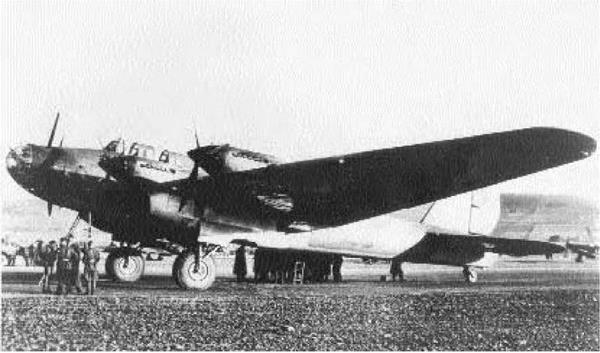. Nanchang Q 5
Type: Light Bomber
Dimensions: wingspan, 31 feet, 10 inches; length, 53 feet, 4 inches; height, 14 feet, 10 inches
Weights: empty, 14,317 pounds; gross, 26,455 pounds
Power plant: 1 x 7,165-pound thrust Shenyang WP6 turbojet engine
Performance: maximum speed, 740 miles per hour; ceiling, 52,000 feet; range, 404 miles
Armament: 2 x 23mm cannons; up to 4,410 pounds of bombs or rockets
Service dates: 1965-
|
T |
he Q 5 is built and marketed as a relatively simple and low-cost alternative to high-priced Western strike aircraft. Although based on outdated technology, it is capable and available in large numbers.
The history of the Nanchang Q 5 dates back to 1958, when the People’s Republic of China began mass-producing copies of the Russian MiG 19 fighter. At that time, the People’s Liberation Air Force sought a dedicated ground-attack craft with better performance than existing MiGs. The program was interrupted in 1961 by the Cultural Revolution and did not recommence until 1965. That June a prototype Q 5 flew for the first time as a highly modified airframe with overtones of the earlier craft. The biggest change was the nose section, which was highly pointed and replaced the frontal intake of the MiG 19 with ones on either side of the fuselage. Other changes included broader wings and an internal bomb bay. The tail control surfaces were apparently retained intact. Around 1970 the Q 5 entered produc
tion and received the NATO designation FANTAN. Roughly 1,000 have been built and are deployed in three main versions. The variant associated with the People’s Liberation Navy carries additional radar and torpedoes. It is also nuclear-capable.
The Q 5 continues to be regarded as a major tactical asset within the Chinese air force judging from the sheer number of machines fielded. The FANTAN is apparently a rugged, capable ground-attack aircraft that can be fitted with a variety of internal and external ordnance, including ground-to-air missiles and bomb clusters. It also mounts a pair of 23mm cannons for defensive purposes. Such cheap, effective machines have decided appeal for poorer Third World countries seeking to enhance their military capabilities. For this reason, Pakistan, North Korea, and Bangladesh all have imported small quantities of Q 5s. The newest version, the Q 5I, has deleted the bomb bay in favor of additional fuel and fuselage hardpoints.
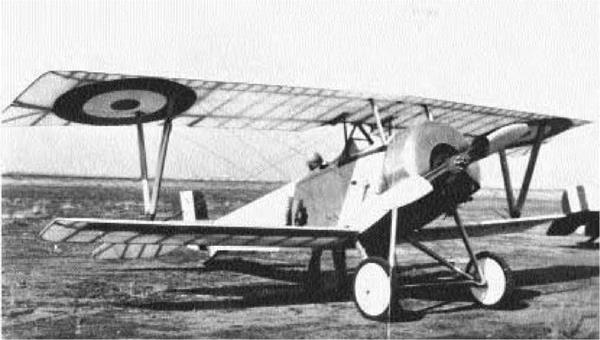
Type: Fighter
Dimensions: wingspan, 24 feet, 9 inches; length, 19 feet; height, 8 feet Weights: empty, 728 pounds; gross, 1,058 pounds Power plant: 1 x 80-horsepower Gnome rotary engine
Performance: maximum speed, 97 miles per hour; ceiling, 15,090 feet; range, 200 miles Armament: 1 x 7.7mm machine gun Service dates: 1915-1916
|
T |
he Nieuport 11 was one of the most famous aircraft of World War I. Light and maneuverable, it helped end the “Fokker scourge” and restore Allied control of the air.
In response to the 1914 Gordon Bennett Air Race, Gustave Delage of Nieuport undertook design of a new and relatively small machine. This craft, which he christened the Bebe (Baby) on account of its size, was built in only four months. It featured conventional wood-and-fabric construction with highly staggered, swept-back wings. The lower wing was slightly shorter than the top, possessed only half the surface area, and was secured by distinctive vee struts. The racer was fast and demonstrated a good rate of climb with superlative flying qualities. Because World War I canceled the air race, the Aviation Militaire (French air service) decided to adopt the airplane as the Nieuport 11 scout. For combat purposes it sported a single Lewis machine gun on the top wing that fired above the propeller arc.
The first Nieuport 11s arrived at the front in the summer of 1915—none too soon for the hard-
pressed Allies. For six months previously the Fokker E III monoplanes had monopolized air combat over the Western Front, inflicting heavy losses. This latest French fighter could literally fly rings around its opponent and, in concert with the de Havilland DH 2 pusher, recaptured air supremacy for the Allies. The Italians were also singularly impressed by the design, and they obtained rights to manufacture it under license. By 1917 Nieuport 11s formed the mainstay of Italian fighter strength and were also widely exported to Belgium and Russia.
In 1916 Nieuport fitted the Bebe fuselage with a more powerful engine and additional armament. The ensuing Model 16 proved as popular as its predecessor, launching the careers of many French aces, including Georges Guynemer and Charles Nungesser. This model was also unique in being fitted with small Le Prieur rockets for shooting down observation balloons. More than 600 Nieuport 16s were constructed, and they remained actively employed until 1917.
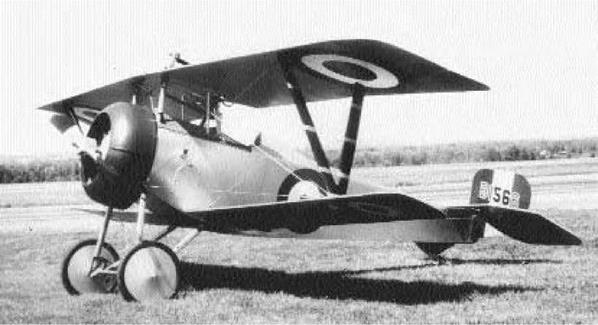
Type: Fighter
Dimensions: wingspan, 26 feet, 11 inches; length, 18 feet, 10 inches; height, 7 feet, 7 inches
Weights: empty, 705 pounds; gross, 1,179 pounds
Power plant: 1 x 110-horsepower Le Rhone rotary engine
Performance: maximum speed, 109 miles per hour; ceiling, 17,388 feet; range, 186 miles Armament: 1 x 7.7mm machine gun Service dates: 1916-1917
|
T |
he Nieuport 17 was one of the most famous warplanes in aviation history. Its dogfighting abilities were legendary, and German aircraft designers felt obliged to incorporate many of its technical aspects into their own craft.
In 1916 Gustave Delage sought to improve upon his existing Nieuport 16 to counteract a tendency toward nose-heaviness and structural failures in the lower wing. The result was a strengthened, lengthened design: the classic Nieuport 17. It featured additional wing area, cleaned-up lines, and a reinforced lower wing. A fully synchronized Vickers machine gun, installed in front of the pilot’s position, also replaced the wing-mounted Lewis weapon. Consequently, the new craft displayed all the agility of older models with none of their vices.
The Nieuport 17 appeared at the front in the summer of 1916, just as the struggle against the Fokker E III monoplanes was climaxing. As with earlier models, it had little difficulty dispatching numerous German adversaries. It also was one of the few Allied aircraft that could hold its own against
the new-model Albatros and Halberstadt D I fighters appearing that fall. Being propelled by a rotary engine, which exerted great torque forces while spinning inside the cowling, Nieuports easily outturned their faster opponents. The Italians were impressed by this compact dervish and obtained a license to manufacture it on their own. The type was also exported abroad to Belgium and Russia with similar results. Moreover, it formed the strength of the American volunteer squadron, the famous Lafayette Escadrille.
Few aircraft are so closely associated with a stable of aces as this legendary Nieuport design. It assisted the careers of such flying legends as Georges Guynemer, Rene Fonck, and Jean Navarre in France, Italy’s Francesco Baracca, Edward Man – nock of Great Britain, and William “Billy” Bishop of Canada. The great British ace Albert Ball was allegedly so attached to his Nieuport that he refused to trade it when ordered to do so! This superlative fighter plane remained in frontline service until 1917 before being superceded by the SPAD VII.
|
Dimensions: wingspan, 28 feet, 8 inches; length, 21 feet; height, 8 feet, 2 inches
Weights: empty, 1,047 pounds; gross, 1,625 pounds
Power plant: 1 x 160-horsepower Gnome Monosoupape rotary engine
Performance: maximum speed, 122 miles per hour; ceiling, 17,000 feet; range, 155 miles
Armament: 2 x.303-caliber machine guns
Service dates: 1918
|
T |
he Nieuport 28 was among the most elegant fighters of World War I but inferior to earlier models. It nonetheless gained renown as the first combat aircraft piloted by newly-arrived Americans.
The appearance of new German fighters in the summer of 1917 prompted Gustave Delage to radically overhaul the design philosophy of his aging Nieuport scouts. A new craft, designated the Nieu – port 28, dispensed with the familiar sesquiplane approach (with one wing longer than the other) and adopted wings of equal length. Moreover, in contrast to the square-tipped wings anchored by vee struts of earlier versions, the new craft sported rounded tips and two-bay, conventional strutting. The graceful fuselage was also circular in cross-section, with a highly streamlined metal cowling. The resulting craft exhibited delightfully stylish lines and proved highly maneuverable with a good rate of climb. Unfortunately, it was also structurally weak, as the leading edge tended to break up during dives. This could lead to the entire upper wing collapsing—with fatal results. In light of additional prob
lems with the 160-horsepower Gnome Monosou – pape rotary engine, the Aviation Militaire (French air service) decided to purchase the more rugged SPAD VII instead.
The Nieuport 28 might have lapsed into obscurity save for developments overseas. In 1917 the United States declared war against Germany and began dispatching the American Expeditionary Force to France. It arrived in the summer and fall of that year wholly destitute of aircraft and eager to purchase modern designs. Because the Nieuport 28 was the only available fighter at the time, 297 of these rejected machines outfitted the 27th, 94th, 95th, and 147th Aero Squadrons in the spring of 1918. Both Douglas Campbell, the first American ace, and Eddie Rickenbacker, the highest-scoring pilot, cut their teeth in these fragile fighters. Other noted fliers such as Raoul Lufbery and Quinten Roosevelt were killed flying them. After a service life of several months, the unpopular Nieuports were finally replaced by SPAD XIIIs. A handful lingered on as racing craft well into the 1920s.
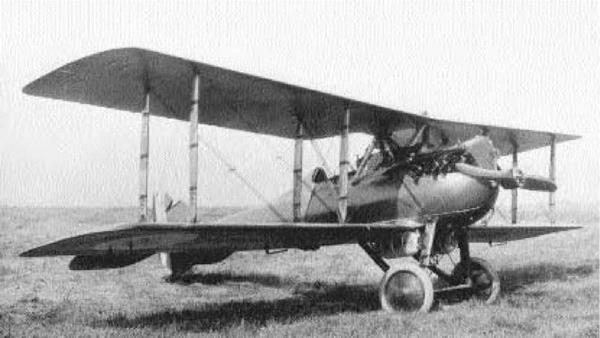
Type: Fighter
Dimensions: wingspan, 31 feet, 10 inches; length, 21 feet, 3 inches; height, 8 feet, 5 inches Weights: empty, 1,675 pounds; gross, 2,535 pounds
Power plant: 1 x 300-horsepower Hispano-Suiza 8Fb water-cooled in-line engine Performance: maximum speed, 146 miles per hour; ceiling, 27,885 feet; range, 360 miles Armament: 2 x 7.7mm machine guns Service dates: 1922-1933
|
T |
oo late to serve in World War I, the Ni-D 29 was one of the best fighters of the 1920s. It served many years in the air forces of France, Italy, Belgium, and Japan.
In 1918 Gustave Delage undertook design of a fighter to replace his less-than-successful Nieuport 28. In doing so he completely forsook the long-standing design norms of the Nieuport company. His new Ni-D 29 differed greatly from previous machines by mounting an in-line, not rotary, engine. It also dispensed with traditional vee struts associated with that company. The new craft was a two-bay biplane of conventional wood-and-canvas design. The wings were of equal length, slightly staggered, and both possessed ailerons. The fuselage was of streamlined monocoque construction with a close-fitting metal cowl over the engine. This necessitated twin radiators to be suspended below the engine and between the landing struts. Delage’s latest creation first flew in June 1918, exhibiting high speed and great maneuverability. The second prototype even established a
world’s altitude record of 29,931 feet in 1919. Having missed World War I, the Ni-D 29 entered production in 1921, with 250 units acquired by fighter squadrons. The craft proved immediately successful, and soon it was redesigned with longer wings and no upper ailerons. This version, the Ni-D 29 C.1, remained in frontline service until 1928.
The Ni-D 29 subsequently became one of the most important and numerous fighter aircraft of the postwar period. It was widely exported abroad, serving with the air forces of Belgium, Sweden, Argentina, and Spain; it was also built under license by Italy and Japan. The Japanese firm Nakajima supplied army air force units with no less than 608 machines (designated Ko 4), which remained in service until 1933. These aircraft saw extensive use during the Manchurian campaign, while French and Spanish Nieuports fought against rebels throughout North Africa. In 1927 a mock dogfight of Ni-D 29s was even staged over Paris between a French pilot and Charles Lindbergh!
|
Dimensions: wingspan (swept) 28 feet; length, 61 feet, 3 inches; height, 19 feet, 6 inches Weights: empty, 31,970 pounds; gross, 61,700 pounds
Power plant: 2 x 8,650-pound thrust Turbo-Union RB.199-34R Mk 104 turbofans Performance: maximum speed, 921 miles per hour; ceiling, 50,000 feet; range, 863 miles Armament: 2 x 27mm cannons; up to 19,841 pounds of rockets, bombs, or gunpods Service dates: 1980-
|
T |
he Tornado is possibly the most flexible multimission aircraft in history. Designed as a strike aircraft, it can also perform air-defense, antishipping, and reconnaissance missions with ease.
In the late 1960s Germany, Italy, and Great Britain joined hands to design a basic ground-attack aircraft that would be built and deployed by all three nations. The new machine would have to operate from short runways, deliver ordnance with pinpoint accuracy, and operate in any weather conditions. It would also be optimized for high-speed/low-level operations that are highly taxing to both crew and airframe alike. After extensive studies, the prototype Panavia Tornado IDS was flown in 1974. It was a compact yet highly complicated aircraft, the first European production design to employ variable – geometry wings. The wings are extremely complicated and designed around a number of high-lift technologies that enable it to become airborne quickly. The craft is characterized by a somewhat short, pointed nose, a long canopy seating two crew members, and a very tall stabilizer. Internally, the
Tornado utilizes advanced fly-by-wire technology, as well as highly sophisticated navigation/attack radar that combines search, ground-mapping, and terrainfollowing capabilities. Around 900 Tornados have been built and acquired by the manufacturing nations since 1980. Several dozen have also been exported to Saudi Arabia.
In 1976 Great Britain wanted to develop an air – defense version on its own accord to replace the aging inventory of English Electric Lightnings and McDonnell-Douglas Phantoms. It desired a fast, flexible interceptor to protect NATO’s northern and western approaches. The new Tornado ADV rolled out in 1976 and is distinguished from the IDS variant by a lengthened nose. It houses the advanced Foxhound radar system, which can track up to 20 targets simultaneously at ranges up to 100 miles. The Royal Air Force currently operates 144 Tornado ADVs, and several have been exported to Saudi Arabia. Both versions saw active duty in the 1991 Gulf War and sustained the heaviest losses of any Allied type. They will continue to serve well into the twenty-first century.
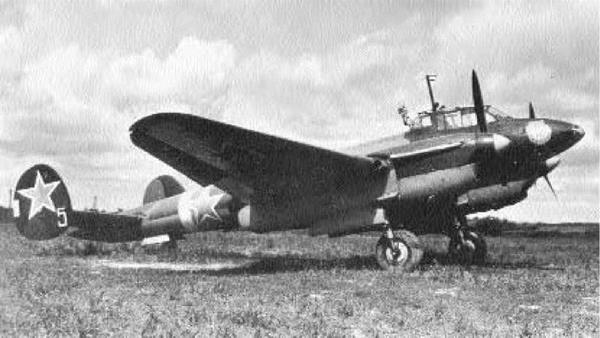
Type: Medium Bomber; Dive-Bomber
Dimensions: wingspan, 56 feet, 3 inches; length, 41 feet, 6 inches; height, 11 feet, 6 inches Weights: empty, 12,952 pounds; gross, 18,726 pounds Power plant: 2 x 1,260-horsepower M-105PF liquid-cooled in-line engines Performance: maximum speed, 360 miles per hour; ceiling, 28,870 feet; range, 721 miles Armament: 2 x 7.62mm machine guns; 3 x 12.7mm machine guns; 6,614 pounds of bombs Service dates: 1940-1945
|
T |
he Pe 2 was Russia’s outstanding tactical bomber of World War II and distinguished itself throughout that conflict. Even when fully loaded, it flew so fast that escorting fighters were hard – pressed to keep up.
In 1938 a design bureau under Vladimir Petlyakov responded to Soviet specifications for a high-altitude fighter with the VI 100. It was an allmetal, twin-engine machine with two rudders and streamlined engine nacelles. A crew of three sat in a spacious cockpit toward the front of the fuselage. In designing the VI 100, careful consideration was given to weight and drag reduction, so bulky radiators were located along the wings while the fuselage employed the smallest possible cross-section. Flight-testing commenced in 1939 with excellent results, but the government changed the role of the craft to high-level bombing. When this proved impractical due to inaccuracy, dive-bombing was substituted, and the plane was fitted with dive brakes. Petlyakov’s design proved successful in this mode, and in 1940 it entered service as the Pe 2.
When war with Germany commenced in June 1941, Pe 2s distinguished themselves in hard – pressed attacks and flew faster than pursuing Bf 109E fighters. Pe 2s were so speedy that they frequently throttled back to allow Lend-Lease Hawker Hurricane escort fighters to keep up. The Pe 2 was also quite strong and could sustain major damage with few ill effects. Successive modifications and stronger engines improved performance and kept them slightly beyond the reach of the newer Bf 109F/Gs. The biggest modifications occurred in 1943, when the wing profile was modified, oil-cooler intakes were reshaped, and bomb mounts received streamlined fairings. The net result was a 25 percent increase in speed. Features to enhance crew survival were also incorporated, including a novel cold – gas bleeding system to suppress fires in the fuel tanks. No less than 11,400 of these impressive machines were constructed. In concert with the smaller Ilyushin Il 2, they were significant contributors to the final Russian victory.
|
Dimensions: wingspan, 128 feet, 3 inches; length, 77 feet, 4 inches; height, 20 feet, 4 inches
Weights: empty, 40,609 pounds; gross, 79,366 pounds
Power plant: 4 x 1,700-horsepower Shvetsov Ash-82FN radial engines
Performance: maximum speed, 280 miles per hour; ceiling, 29,525 feet; range, 2,920 miles
Armament: 2 x 7.62mm machine guns; 2 x 12.7mm machine guns; 8,818 pounds of bombs
Service dates: 1940-1950
|
T |
he Pe 8 was an excellent heavy bomber, but the Soviet High Command had little regard for strategic bombing. Despite great range and a good payload, this potentially useful weapon remained a minor player in a very big war.
In 1934 the Soviet government announced specifications for a fast long-range bomber to replace the Tupolev TB 3s in service. It devolved upon the Tupolev design bureau to create such a craft, although under the aegis of Vladimir Petlyakov. The new machine, initially designated TB 7, first flew in December 1936 as an all-metal, midwing monoplane with power turrets and retractable landing gear. A unique feature was the peculiarly thick wings; these allowed crew members to crawl to the inboard engine nacelles and man rear-firing machine guns. Initial flights were also impressive, as the TB 7 reached
30,0 feet at speeds exceeding the latest German fighters. They entered production in 1937, but only 79 of these excellent machines were constructed.
This was because the Soviet High Command wanted great numbers of smaller two-engine tactical bombers to operate at low altitude in support of Red Army units. Thus, Soviet long-range bombardment aviation took a permanent backseat to battlefield considerations.
During the initial stages of World War II, the big Pe 8s were actively employed, but seldom in the capacity for which they were designed. On the night of August 11, 1941, several managed to bomb Berlin, and subsequent raids were conducted deep behind German lines. But compared to British and U. S. efforts, these were mere pinpricks. However, in May 1942 a Pe 8 made headlines when it flew by stages from Moscow to Washington, D. C., bearing Prime Minister V. M. Molotov. This successful round-trip flight, totaling over 11,000 miles, was a considerable achievement and eloquent testimony to the soundness of Petlyakov’s design. After the war several Pe 8s remained employed as engine testbeds until 1950.











